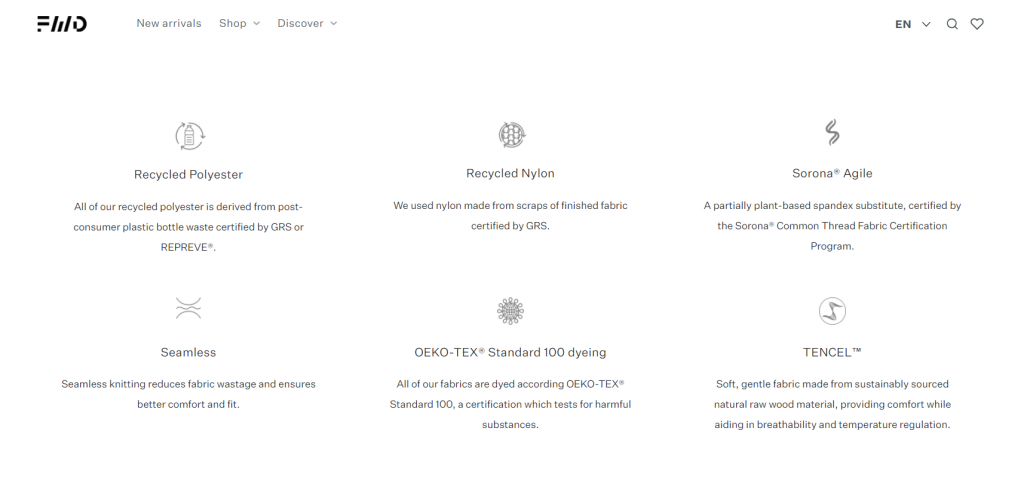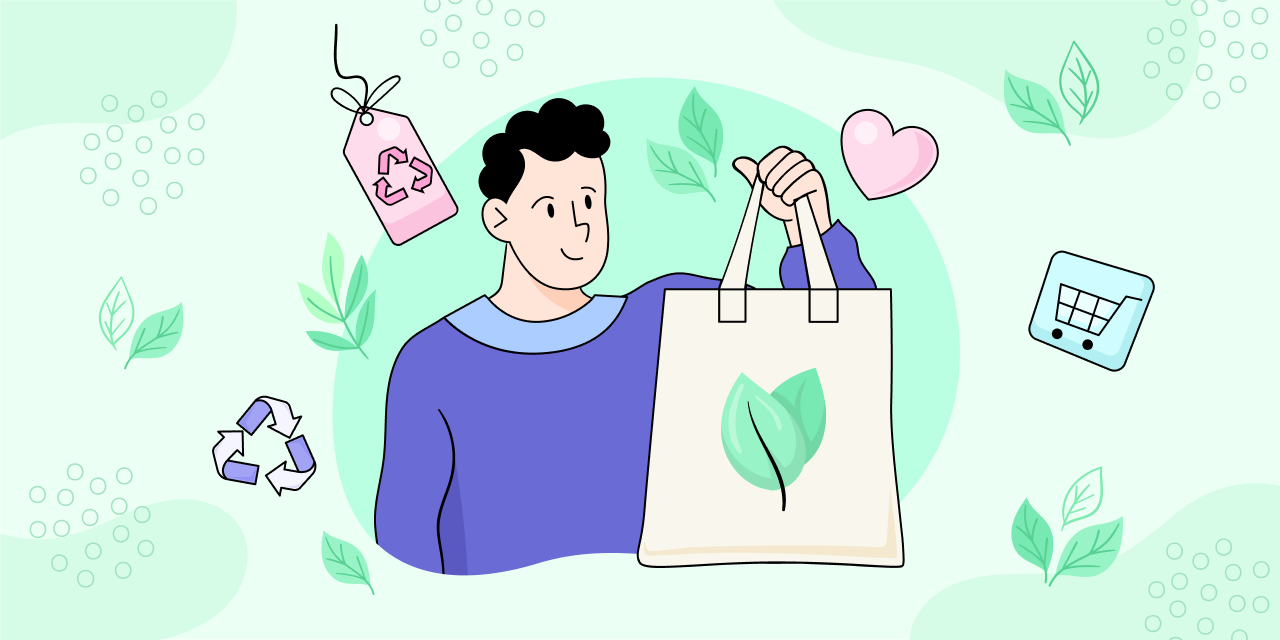From reducing waste during packaging to using eco-friendly content in production, there are many ways for eCommerce brands to practice sustainability and make a positive impact on the environment. However, with so many options out there, it can be difficult to know where to start.
The world is shifting toward sustainability. Consumers, unlike in the past, now think about the impact of their purchasing decisions on the environment.
A study by NielsenIQ reports 73% of consumers are willing to change their buying habits for a sustainable planet. With that, eCommerce brands like yours are in need of adjusting their business policy towards sustainable practices.
Sustainability means balancing economic growth while being environmentally responsible for creating a better world. Now, you may be wondering what it has to do with your brand.
In eCommerce, sustainability is about running your business in a way that doesn’t harm the environment or use too many resources, leaving an inadequate amount for the upcoming generations.
Significance for Your Brand
Modern shoppers look for brands that adhere to their values and principles. Aside from just ethical values, sustainability can also have a significant impact on shaping your Return on Investment (ROI).
How? By reducing waste, using eco-friendly materials, and optimizing energy consumption, you can add to your savings in the long run. Such practices give you the advantage of attracting ethically conscious customers who don’t mind paying even more in exchange for eco-friendly goods.
The purpose of this article is to provide eCommerce businesses with actionable tips to make them ready for a consumer base that thrives on everything sustainable, starting from packaging to the product itself. So, let’s get right into it!
Embracing Eco-friendly Packaging Materials
Nowadays, eco-friendly packaging is at the heart of sustainable eCommerce. In fact, 67% of online shoppers want to receive their orders in recyclable packaging. It’s about time you live up to their expectations.
How to do so? Get started by choosing biodegradable packaging materials made from cornstarch, jute, sugarcane, and any other natural sources. Such materials are suitable for reducing the amount of waste that ends up in landfills. Besides, they present customers with a tangible way to support sustainability.
However, your eco-friendly packaging is not confined to materials only. The design and build of your packaging also matter to a great extent. Out of all the available packaging, choose the multipurpose options for orders and deliveries. For instance, instead of using traditional shipping boxes, switch to a box that can be used for storing items. With this, your customers will be able to reuse the boxes, giving them a second life.
Reducing Materials Usage and Packaging Size
Did you know packaging materials hold up to 65% of household waste? Even a few years ago, your packaging used to be more than just a box with some bubble wrap. It was considered an extension of your brand and an important factor in customer satisfaction. However, with the rise of sustainable eCommerce, this is not the case anymore.
Conventional packaging no longer aligns with consumer preferences. A report from Statista shows over 50% of consumers based in the US and UK expect online brands to deliver items with reduced packaging. So, here comes the necessity for reforming your packaging plan.
The initial step is to evaluate your current packaging material usage per order and find ways to reduce it. How about asking yourself the following questions:
- Can I shift to a lighter-weight material without sacrificing protection on the way to delivery?
- Can I cut off excess padding and filler materials?
If the answer to these questions is a YES, you are good to act accordingly and reduce your material usage. Also, you can consider alternate packaging formats. A possible example can be more compact designs that are still capable of protecting the items during dispatch.
Before moving on to reduce packaging size, you have to hit the sweet spot between protection and efficiency. Once you figure it out, the next step is to put it into action.
Choose the smallest possible packaging that provides adequate support to the items against bumps and friction. Custom packaging that fits your products like a glove reducing the overall packaging size can be a good solution. Also, check out flat-pack and collapsible boxes that can be easily assembled and flattened when needed.
Sourcing From Vendors Who Practice Sustainability
Sustainable vendors are the ones who prioritize fair labor practices and transparent business operations, which can help you build an environmentally responsible brand.
Of course, finding sustainable vendors is easier said than done! It requires a detailed understanding of your supply chain, a willingness to ask thoughtful questions, and demands accountability from your suppliers. But the effort is worth taking.
To find sustainable vendors, start by doing your research and look for the following certifications or labels:
- Rainforest Alliance: For agricultural, plant-based, and forestry products and tourism companies recognized by the Global Sustainable Tourism Council.
- Green Business Bureau (GBB): Suitable for small to medium-sized enterprises seeking recognition for their sustainable efforts.
- Standard 100 by OEKO-TEXÒ: For textile products made without harmful chemicals.
- Fairtrade: For agricultural crops and manufactured goods.
- Leaping Bunny: For beauty, personal care, and cleaning products.
- Certified B Corporation: For businesses that meet the highest standard of showing environmental and social responsibility.
- Positive Luxury: For luxury brands that showcase a profound commitment to ethical values.
These labels can help you identify vendors who meet certain sustainability standards. You can also reach out to industry associations and trade groups to get recommendations and connect with like-minded vendors to grow your business.
Showcasing Your Sustainability Efforts
Whether through the website, product packaging, or marketing campaigns, displaying your sustainability efforts can help you build trust with customers and make your brand stand out in a crowded landscape.
To make your sustainability practices more transparent on your website, you can follow the lead of the online apparel store Forward With Design (FWD). The FWD’s website shows detailed information about the actions they take for the production of goods to reduce their environmental impact. This includes using eco-friendly materials such as recycled polyester and nylon, partially plant-based spandex substitutes, TENCEL™, and more.

Another way is to add labels and stickers on your packaging to highlight your eco-friendly practices. This can make a huge impact on customers and give an impression that you’re serious about making a difference.
You can deliver orders with careful packaging labeled with stickers – “100% Recycled Content” or “Made with Renewable Energy”. And your customers, upon receiving the order and reading those labels, will feel like they have made the right decision by choosing your brand.
Supporting Sustainable Shipping Practices
Traditional shipping methods can contribute to your brand’s carbon footprint. So, choosing carriers prioritizing sustainability is always a good idea.
Go for shipping carriers that are committed to reducing emissions and using alternative fuel sources to minimize consumption. You can even find carriers that offer carbon-neutral shipping options, which allow you to offset the emissions generated by your shipments.
Some examples of shipping companies focusing on sustainable practices are as follows:
- FedEx: FedEx has set a goal of becoming carbon neutral by 2040 and has been implementing sustainable practices such as using zero-emission electric vehicles and renewable energy sources.
- DHL: DHL is on a mission to achieve zero emissions by 2050. This shipping carrier has also been investing in alternative fuel vehicles, energy-efficient warehouses, and renewable energy sources to support sustainable development.
- UPS: UPS is implementing sustainable logistics practices through the use of alternative fuel vehicles and smart recharging infrastructure. Their goal is to achieve carbon neutrality by 2050 and power 40% of their ground operations with sustainable fuels by 2025.
- USPS: The United States Postal Service (USPS) plans to invest $9.6 billion in an effort to become more environmentally sustainable. As a part of this plan, they aim to modernize their delivery by replacing 66,000 traditional delivery vehicles with electric ones.
Ditching Cash On Delivery (COD)
Cash On Delivery, aka Collect On Delivery, has long been a popular payment method for online businesses. But this practice comes with a huge environmental cost due to the consumption of paper.
If your online store offers Cash On Delivery as one of the payment options, it’s time to stop this practice for the sake of the environment. As an alternative, switch to online payment methods like PayPal, Google Wallet, Amazon Pay, etc., and encourage your customers to make payments through these options.
Such payment options can mitigate carbon footprint and paper consumption as they eliminate the need for cash transactions and the exchange of receipts. Additionally, switching online can save the time you spend managing cash payments for your business.
Time to Get Into Action
By now, we hope that we’ve successfully sparked your interest in introducing sustainable practices into your brand. However, if you’re already practicing sustainability and want to showcase your brand’s eco-friendly efforts, Bevy Commerce is here to assist!
We have already helped brands like Forward With Design, Samara Bags, and Quil Packaging make their commitment to the environment known through their websites. Our team of experienced developers and designers can also help you get a head start on your website redesign and ensure your sustainability practices are front and center.
Contact us today, and let’s work together to build a more sustainable future!








